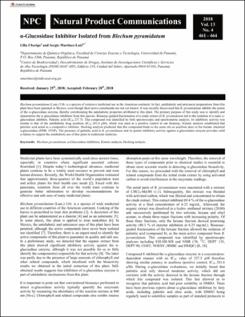| dc.contributor.author | Cherigo, Lilia | |
| dc.contributor.author | Martínez-Luis, Sergio | |
| dc.date.accessioned | 2020-07-18T20:25:51Z | |
| dc.date.available | 2020-07-18T20:25:51Z | |
| dc.date.issued | 2018-02-28 | |
| dc.identifier.other | doi.org/10.1177/1934578X1801300421 | |
| dc.identifier.uri | http://repositorio-indicasat.org.pa/handle/123456789/206 | |
| dc.description | Blechum pyramidatum (Lam.) Urb. is a species of extensive medicinal use in the American continent. In fact, antidiabetic and anticancer preparations from this plant have been patented in Mexico, even though their active constituents are not yet known. It was recently discovered that B. pyramidatum inhibits the action of the -glucosidase enzyme, thereby corroborating the antidiabetic properties attributed to this plant. The primary purpose of this study was to identify and characterize the -glucosidase inhibitors from this species. Bioassay-guided fractionation of a crude extract of B. pyramidatum led to the isolation of a main - glucosidase inhibitor, Palmitic acid (IC50 237.5). This compound was identified by both spectroscopic and spectrometric analysis. Its inhibitory activity was similar to that of the antidiabetic drug acarbose (IC50 241.6 µM), which was used as a positive control in our bioassay. Kinetic analysis established that palmitic acid acted as a competitive inhibitor. Docking analysis predicted that this compound binds to the same site as acarbose does in the human intestinal α‑glucosidase (PDB: 3TOP). The presence of palmitic acid in B. pyramidatum and its potent inhibitory activity against α‑glucosidase enzyme provides solid evidence to support the antidiabetic use of this plant in traditional medicin | en_US |
| dc.description.abstract | Blechum pyramidatum (Lam.) Urb. is a species of extensive medicinal use in the American continent. In fact, antidiabetic and anticancer preparations from this plant have been patented in Mexico, even though their active constituents are not yet known. It was recently discovered that B. pyramidatum inhibits the action of the -glucosidase enzyme, thereby corroborating the antidiabetic properties attributed to this plant. The primary purpose of this study was to identify and characterize the -glucosidase inhibitors from this species. Bioassay-guided fractionation of a crude extract of B. pyramidatum led to the isolation of a main - glucosidase inhibitor, Palmitic acid (IC50 237.5). This compound was identified by both spectroscopic and spectrometric analysis. Its inhibitory activity was similar to that of the antidiabetic drug acarbose (IC50 241.6 µM), which was used as a positive control in our bioassay. Kinetic analysis established that palmitic acid acted as a competitive inhibitor. Docking analysis predicted that this compound binds to the same site as acarbose does in the human intestinal α‑glucosidase (PDB: 3TOP). The presence of palmitic acid in B. pyramidatum and its potent inhibitory activity against α‑glucosidase enzyme provides solid evidence to support the antidiabetic use of this plant in traditional medicin | en_US |
| dc.format | application/pdf | |
| dc.language.iso | eng | en_US |
| dc.rights | Info:eu-repo/semantics/openAccess | |
| dc.rights | https://creativecommons.org/licenses/by/4.0/deed.es | |
| dc.subject | Blechum pyramidatum | en_US |
| dc.subject | Glucosidase inhibition | en_US |
| dc.subject | Kinetic analysis | en_US |
| dc.subject | Docking analysis. | en_US |
| dc.title | α-Glucosidase Inhibitor Isolated from Blechum pyramidatum | en_US |
| dc.type | info:eu-repo/semantics/article | en_US |
| dc.type | Info:eu-repo/semantics/publishedversion | |

